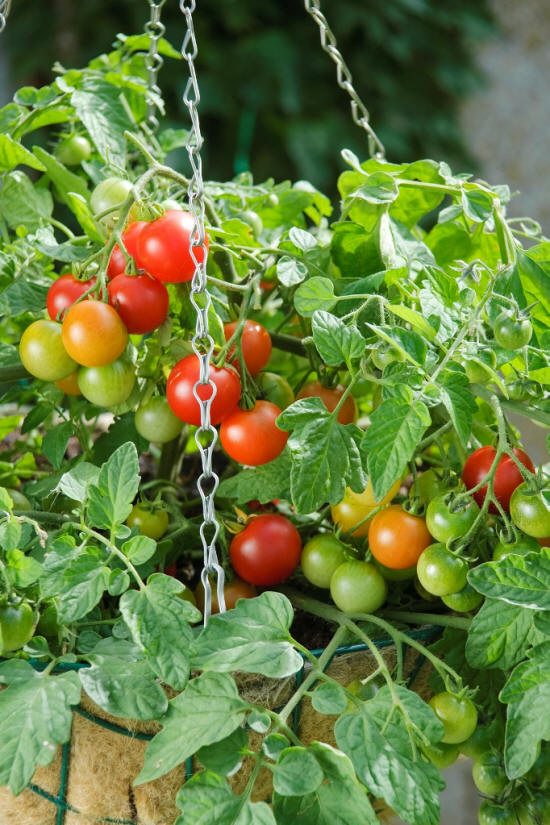|
 Growing
Tomatoes in Pots Growing
Tomatoes in Pots
By Melinda Myers
 Send a link to a friend
Send a link to a friend
[May 17, 2022]
Keep garden-fresh tomatoes close at hand this
season. Grow one or more in containers on your patio, balcony, or
front steps.
Any tomato can be grown in a pot, but determinate varieties are
smaller and more compact, so they are a bit easier to manage in a
container. They produce fruit in a relatively short period of time,
making them great choices for preserving as well as using fresh.
Look for a D or determinate on the plant tag, seed packet or in the
catalog description.
|
|
 Indeterminate tomatoes, often identified with an
I, are large, sprawling plants. These are usually staked or grown in
wire cages to save space, reduce pest problems and make harvesting
easier. They continue to grow, flower, and produce fruit until the
frost kills the plant. Indeterminate tomatoes usually produce more
tomatoes, but the harvest is later in the season than determinate
varieties. New containers with built-in trellises or creative
gardeners crafting their own makes growing indeterminate tomatoes in
pots an easier possibility. Indeterminate tomatoes, often identified with an
I, are large, sprawling plants. These are usually staked or grown in
wire cages to save space, reduce pest problems and make harvesting
easier. They continue to grow, flower, and produce fruit until the
frost kills the plant. Indeterminate tomatoes usually produce more
tomatoes, but the harvest is later in the season than determinate
varieties. New containers with built-in trellises or creative
gardeners crafting their own makes growing indeterminate tomatoes in
pots an easier possibility.
Grow one tomato per container for maximum productivity. Use a
5-gallon or bigger container for large varieties and at least a two
to three gallon or similar size pot for smaller varieties. Some
research suggests growing tomatoes in a pot that is at least 14
inches but preferably 20 inches wide will yield greater results.
Adding flowers and herbs to the container boosts the beauty and
diversity of your container garden but will reduce the number of
tomatoes produced.
Growing tomatoes in containers also allows you to extend the season.
Start earlier by moving the planter inside when the weather is harsh
and back outside when the weather is warm and sunny. As the weather
turns cold at the end of the growing season, cover the planter or
move it into a frost-free location as needed. Some gardeners even
move a pot or two inside to finish off the tomato season.
Grow tomatoes in a container with drainage holes or a self-watering
pot that has a reservoir to hold water and extend the time between
watering. Further reduce the need to water by adding an organic,
sustainable soil amendment like Wild Valley Farms’ wool pellets (wildvalleyfarms.com)
to the potting mix. Made from wool waste, this product reduces
watering by up to 25%. Adding a low nitrogen, slow-release
fertilizer at planting will eliminate the need to fertilize weekly.
Just make a second application, if needed, mid season.
[to top of second column] |

Plant tall tomato transplants a few inches deeper
than they were growing in their container. Remove the lowest leaves
that would otherwise be buried in the soil. Cover with soil and
water. This is also a good time to install any stakes, trellises, or
cages to support taller varieties.
Initially, check tomatoes growing in containers every
day and water often enough to keep the developing root system moist.
Reduce watering frequency as plants become established. Feel the top
few inches of soil and water the established plants thoroughly
whenever this is dry. Mulch the soil with evergreen needles,
shredded leaves, or other organic mulch to keep the soil
consistently moist and suppress weeds. Consistent soil moisture
encourages more flowering and fruiting, while reducing the risk of
blossom end rot, cracking, and misshapen fruit.

Harvest tomatoes when fully colored or leave them on the plant a few
more days for an even sweeter flavor. You’ll enjoy the convenience
of harvesting fresh tomatoes right outside your door for use in
salads, sauces, and other favorite recipes.
Melinda Myers has written more than 20 gardening books, including
Small Space Gardening and Midwest Gardener’s Handbook, 2nd Edition.
She hosts The Great Courses “How to Grow Anything” DVD series and
the nationally syndicated Melinda’s Garden Moment TV & radio
program. Myers is a columnist and contributing editor for Birds &
Blooms magazine and was commissioned by Wild Valley Farms for her
expertise to write this article. Myers’ website is
www.MelindaMyers.com.
[Photo courtesy of All-America
Selections] |